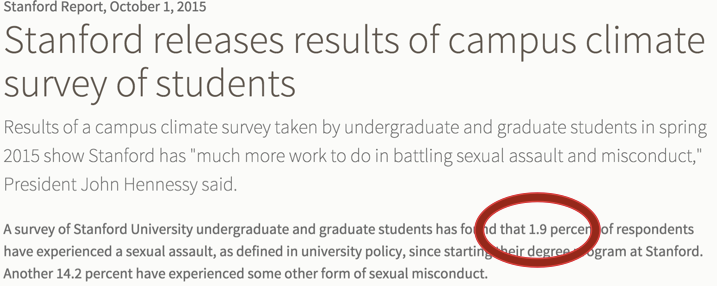
Students at Stanford University are frustrated.
Multiple protests over how the university handles sexual assault have beset Stanford's Palo Alto campus in the past two years. The U.S. Department of Education's Office for Civil Rights has four concurrent investigations open into whether Stanford violated the gender equity law Title IX in its response to reports of sexual assault. Faculty has issued an open letter criticizing the school's proposed changes to its policy handling sexual harassment and assault.
At a well-attended town hall in November, students challenged how the administration is dealing with sexual violence, to which Provost John Etchemendy responded that it wasn't pushing anything "under the rug" or trying to downplay the issue. Other students disagree.
"This became really real to me after the town hall and seeing people crying and not being heard," said Stephanie Pham, a sophomore who co-founded the campus activist group One In Five. "They're not being heard, they're being silenced."
All of this criticism came prior to a report Friday by The Huffington Post about how a student accused of physical and sexual assault escaped punishment until after he graduated, and was never referred to law enforcement.
HuffPost reported last week that multiple women said they were sexually and physically assaulted at Stanford by the same man at different points between 2010 and 2014 -- one woman even said he choked her until she nearly passed out. While each woman had their own reasons to deliberate over whether to report at all, each said they hesitated launching an official university investigation, citing negative experiences they'd heard from classmates who went through the process.
Many Victims Avoid Reporting Assaults To Stanford, With Reason
A survey of Stanford students last year showed just 2.7 percent of victims reported their sexual assaults. A majority of survey respondents did believe the school would hold accountable someone found responsible for sexual assault, though there was a significant gender gap, with women less likely to feel that way.
"It isn't so much people being afraid to report, it's that when they do report, the cases are not always handled properly," said Michele Dauber, a Stanford law professor. "It's doubtless there are people who take a look at the process who say, 'I don't want that, I had a friend go through that, and I don't want it.'"
Stanford was already put on notice that women may not feel comfortable reporting assaults. One student, Tess Bloch-Horowitz, was so dismayed at the retaliation she faced last spring for participating in an investigation about a sexual harassment incident that she publicly declared she wouldn't feel comfortable reporting an actual sexual assault to the university.
In 2014, Stanford students protested after undergraduate Leah Francis revealed that a male student was found responsible for sexual assault using force and would be punished with a five-quarter suspension and community service -- but that sanction would not take effect until after he received his diploma, which essentially just created a "gap year" before he could start grad school at Stanford.
Stanford spokeswoman Lisa Lapin said the school is "evaluating the comments" from the campus community about proposed reforms to the policy for adjudicating sexual violence.
"We expect to issue the revised process in the next couple of days, and it will take effect in February," Lapin said Friday. "It will be a pilot process, meaning that changes can still be made to it, and it will still need to go through several campus representative bodies before being adopted as ongoing university protocol."
There are many reasons why a student may not report their assault, Lapin said, but Stanford provides confidential resources for victims "in a supportive and caring environment, to help students evaluate their options."
Students Call For Do-Over Of Sexual Assault Survey
Throughout these controversies, however, some students and faculty say Stanford is showing a response that prioritizes its public image over actual improvements.
One of the principal examples cited by Stanford critics is how the university rolled out a recent climate survey that was supposed to gauge how often sexual assault happens on campus. They note the survey report leads with boasting about how students say they "perceive a positive campus climate," and then suggests just 1.9 percent were sexually assaulted. But that number was found by combining men and women, and narrowly limiting the definition -- like excluding "nonconsensual sexual penetration" -- of what constituted sexual assault.
Announcing to the public that just 1.9 percent of survey respondents were sexually assaulted is a distortion of the reality on campus, considering 7.5 percent of undergraduate women in the survey said they've experienced "penetration without consent."
Stanford "cherry-picked and manipulated data," said Tessa Ormenyi, a research assistant at the university, and isn't using the survey results "to learn from past mistakes, but as bad press that hurts a brand."
"Ironically, the 1.9 percent figure actually has been used much more extensively by critics than by the university," Lapin told HuffPost, a comment she's made to multiple other media outlets.

So upset was the university’s student government with the survey’s release that it unanimously passed a resolution last week calling on Stanford to entirely redo the report.
"It is more difficult to address the sexual assault issue if Stanford administrators and the student body do not know the full truth about the situation at Stanford," Matthew Cohen, the sponsor of the student government resolution, wrote in the student newspaper last week. "Right now, Stanford is trying to tackle this issue with blinders on."
Problems Mount In Court
Aside from problems with how Stanford handles reports of sexual violence among students, legal battles have accused the university of inappropriately responding to sexual harassment among staff at the university.
Recent court papers claimed Stanford downplayed accusations of a donor's "lewd" behavior from multiple women. (Stanford said it investigated and did not find sexual harassment.)
Separately, a lawsuit by former professor Jim Phills against the university and the dean of Stanford's business school, Garth Saloner, claims Saloner slept with Phillis' estranged wife and then conspired with her to force him out of his job. Stanford and Saloner have denied the charges, but business school employees have claimed over the course of the litigation that Saloner's leadership is marked by "personal agendas, favoritism, and fear," and led to many women resigning from senior staff positions.
"If the university administration decides to issue a new campus climate survey, I think that could help persuade some skeptical people to have more faith in the university handling sexual assault and misconduct," Cohen told HuffPost.
Dauber believes university officials could regain trust from students if they change how they publicly address the issue.
"The answer is to be transparent about the data, be straightforward about the goals, and always be trying to move the needle in the right direction," Dauber said. "That means you can't be defensive as an organization. You can't hear these problems and say, 'That wasn't our fault -- our staff is excellent.'"
_______
Tyler Kingkade covers higher education and sexual violence, and is based in New York. You can reach him at tyler.kingkade@huffingtonpost.com, or find him on Twitter: @tylerkingkade.
Related Coverage:
- How A Stanford Student Accused Of Assaulting Multiple Women Graduated
- Columbia Students Reveal How The University Dragged Out Sexual Assault Investigations
- Why Even Small, Progressive Grinnell College Has Trouble Dealing With Sexual Assault On Campus
- How Rolling Stone's UVA Story Sparked A Controversial Frat Lobbying Effort
- In One Woman's Sexual Assault Case, Police Succeeded Where Her College Failed
